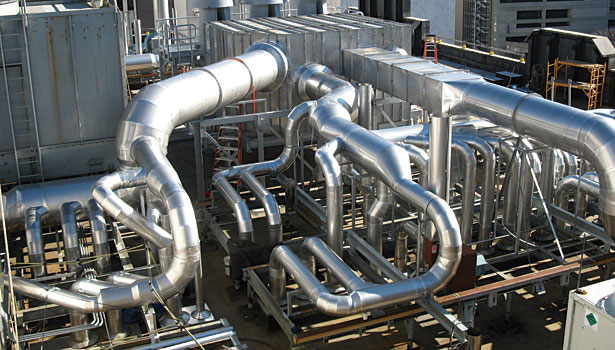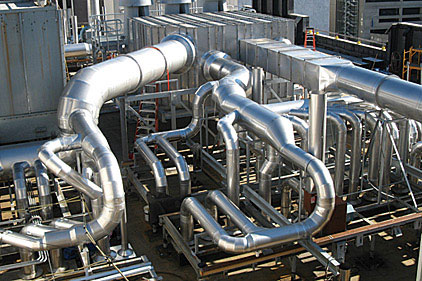
|
| The University of Georgia employed mixed flow impeller technology to accomplish IAQ and energy goals at its Natural Science Center. The university accomplished six goals with one solution. |
Georgia State’s Natural Science Building in Atlanta houses over 150 laboratory workstations for 350 to 400 permanent faculty and graduate students, with as many as 10,000 “floating” students in the labs each the week. Workstation exhaust fume hoods had been serviced by individual belt-driven exhaust fans dedicated to individual exhaust stacks.
“We were having problems since the beginning with loose and/or broken fan belts; and in laboratories with more than one fume hood, workstation exhaust was traveling through the work space to adjacent workstations,” said Momen.
This was creating IAQ safety concerns. In addition, the belt-driven fans created maintenance headaches. And there were other is-sues, including high energy costs, concerns over re-entrainment into the building and adjacent buildings, quiet operation in lab and on the roof, and assuring compliance with air pollution standards.
Momen addressed all six concerns with one solution.
“After discussing each of these issues, we hired Johnson, Spellman and Associates to design an entirely new exhaust system for our laboratories,” he said.
However, this was easier said than done due to physical and mechanical limitations. Also, the building was fully occupied by stu-dents. All work had to be done with minimal disruption.
“We worked in multiple stages to determine the most suitable time frame for installation of the new systems’ components,” said Momen.
While researching the project, the design team discussed alternatives for the most practical solution. As it turned out, one solution was already in place at the university. That solution was an existing centrally manifolded mixed-flow technology impeller system on the building’s roof.
From that point, this technology was looked at very carefully before it was determined that it offered advantages to meet all six re-quirements.
INTEGRATING NEW TECHNOLOGY
Mark Rood, a mechanical engineer with Johnson, Spellman and Associates, was the lead project manager at Georgia State and worked closely with Momen to replace the laboratory exhaust systems.
Rood said his firm was familiar with the type of technology that was ultimately installed at the university.
“The system we suggested for Georgia State is a manifolded system with a portion of the ductwork on the roof and multiple mani-folds for each mixed-flow fan cluster,” he said.
Rood explained the project was essentially a retrofit job and they needed to retain all of the duct risers from seven floors of the building up to the roof.
“All existing duct risers were stainless steel and in good shape. They served about 100 individual laboratory workstation fume hoods in the building,” he said
There were also general exhaust risers that served the laboratory rooms, and because they were all in good condition, there was no need to replace them.
However, the team had to deal with 130 individual duct risers that came up through the building and extended to the roof, which Rood said “was no easy task.”
He also explained that the renovation project involved tying into those 130 risers and combining them in order to accommodate the multiple groupings of the mixed-flow impeller systems.
A MULTI-DISCIPLINE SOLUTION
In most cases, major renovation projects like this involve many disciplines over long time periods.
“We were involved with site investigation of the existing laboratory supply air and exhaust duct systems,” said Rood. “We worked closely with the architect, a roofing designer, structural engineers, and electrical engineers as sub-consultants on the project.”
HVAC design services and full contract administration during the construction phase were also accomplished. While describing other project details, Rood said the scope of the mechanical work included removing all the dedicated belt-driven exhaust fans from the university’s five-story research laboratory building. There were 95 associated with laboratory workstation fume hood exhaust and 10 that provided general exhaust in the laboratory rooms.
The existing fans that were used for the laboratory workstations were a utility set type with each ducted to a dedicated rooftop ex-haust stack about 10 ft high.
This caused many limitations, including the available roof area for placement of the new mixed-flow impeller fans, which also constrained the ability to remove some of the existing exhaust fans at any one time. Limitations were also imposed by the existing concrete structure, and the need to maintain service access to the new fans.
It was for all these reasons that everyone involved in the project agreed that the use of the high vertical plume discharge, direct-drive Tri-Stack® mixed-flow impeller systems made the most sense.
As part of the evaluation process, the team worked with Rowan, Williams, Davies & Irwin Inc., consulting engineers (Guelph, Ontario). RWDI specializes in building exhaust wind studies to determine predicted exhaust air flow under a wide variety of atmospheric conditions.
The design teams’ approach involved replacing the individually dedicated workstation exhaust fans with their associated tall stacks with just ten manifolded mixed-flow impeller exhaust fans segregated into three groups on the fifth story lower roof of the building.
Mixed-flow impeller technology does exactly what its name implies: it mixes diluted outside (ambient) air with laboratory workstation fume hood exhaust to effectively dilute the exhaust stream, discharging a powerful, vertical plume hundreds of feet above the roofline. RWDI was able to determine that the three proposed groups of Tri-Stack fans, each only 15 ft high above the building’s lower roof, would operate within safe parameters.
THE COMPLETED PROJECT
The final project results included installation of three groups of mixed-flow impeller systems. These systems exhibit extremely low roofline profiles—typically about 15-ft high, which eliminated the perception of a neighborhood polluter.
The laboratory’s existing direct digital control system was also extended to provide monitoring and control of the static pressure in each branch of the exhaust duct system.
Another key advantage of the new exhaust systems, according to Momen, is significantly lower energy costs. Because of their effi-ciency, mixed-flow impellers can operate at slower speeds with significantly less current draw. In the case of Georgia State, this is about 50% of their total capacity.





